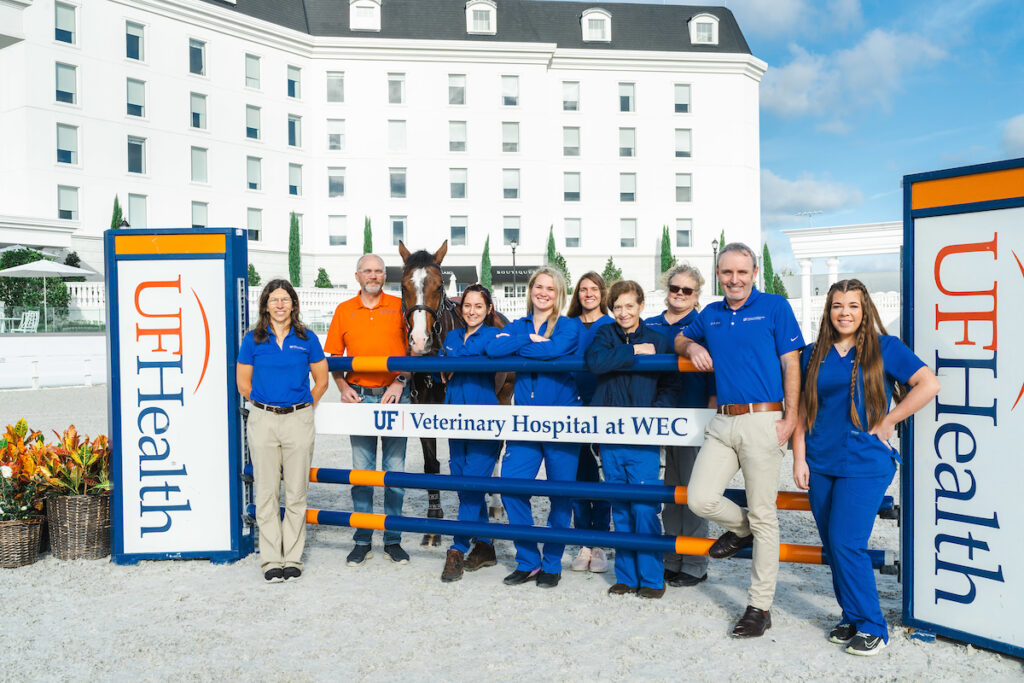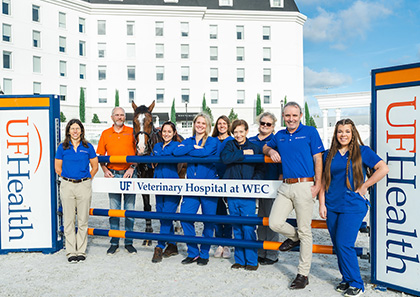
By: UF Veterinary Hospital
University of Florida Veterinary Hospital at World Equestrian Center – Ocala (WEC) offers leading-edge care to equine athletes on-site as well as horses from the surrounding area. No matter what brings you to WEC – Ocala, our team of board-certified specialists are here to serve you with an unprecedented array of equine veterinary services.
As we enter the 2024 Winter Spectacular Show Series, we wanted to highlight some of the key services and expertise available to our equine athletes. Our equine veterinarians are board-certified in equine sports medicine and are experienced performance horse veterinarians with broad skill sets. Well-versed in the demands of each individual horse sport, we provide a range of treatments to ensure your horse performs at its best.
We offer ACVSMR performance evaluations for lameness, purchase, neurologic, respiratory, poor performance as well as gastrointestinal tract and cardiac examinations. Additionally, for eye concerns or conditions, a board-certified ophthalmologist is available for ophthalmic examinations one day twice monthly.
A variety of rehabilitation treatments and programs are available, including aquatread, halotherapy (salt room), vibration therapy, laser, solarium and therapeutic ultrasound. Our equine specialists can discuss which program would best meet your horse’s need to return to performance or keep that athletic edge.
The UF Veterinary Hospital at WEC offers a wide range of diagnostic imaging modalities at one site. Our CT unit is a state-of-the-art and takes mere seconds to scan your horse once it is positioned either standing for head and distal limbs or under general anesthesia for pelvis, stifle, shoulder, elbow and the most caudal portion of the neck Standing positron emission tomography, or PET, uses an injectable radioactive material to highlight areas of pathology that might be causing lameness from the horse’s foot to just above the carpus and tarsus. PET can be used as a screening tool if the nerve or joint blocks are not definitive about the exact region causing the lameness, your horse is not amenable to nerve or joint blocks, or if there are multiple areas of suspicion of problems on other diagnostic imaging. It acquires 3D images that can be fused with MRI or CT images.
We also offer standing low-field MRI, which allows us to image limbs of the horse below the carpus or tarsus while standing and sedated. MRI is a useful for diagnosing any lameness condition that has been localized in the lower limb, especially in the foot, in situations where X-rays or ultrasound have not provided adequate answers. Additionally, our high-powered X-ray generator allow us to obtain high quality images of regions that portable machines struggle to adequately penetrate, including caudal cervical thoracic and lumbar vertebrae, thorax (chest), and abdomen.
Supporting our equine veterinarians are board-certified veterinary radiologists with specialty certification in equine diagnostic imaging who provide real-time feedback ensuring the highest quality imaging for your horse.
Learn more about all of our services at hospitals.vetmed.ufl.edu/wec or contact us at 352.414.3858 for information and appointments. Hours of operation for the equine hospital are Monday through Saturday, 8am to 5pm. Visit us on Facebook @UFVHWEC and on Instagram @UFVH_WEC.


